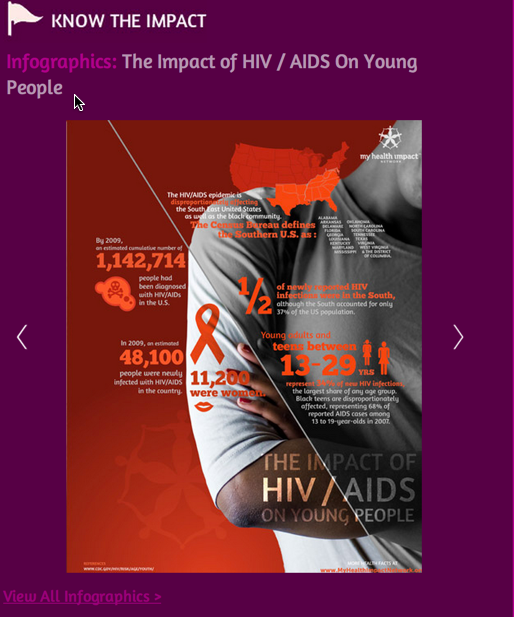myHIN Blog
Category: STDs Safe Sex Facts Articles

July 22, 2014
Black America’s Silent Epidemic – Outtake of @OWNTV @Lisaling – Our America
We watched the June 26, 2014 Our America series on OWN. In this series, journalist Lisa Ling covered the HIV epidemic in Black America. Our team watched intently and followed the Twitter hashtag during the show. What would be different about this coverage? How would the Black community be portrayed? Would this be, yet, another depiction of all things wrong in and with the community? How would it reach young people, the millennials?
Here are comments below from the research scholars (millennials) on the MyHealthImpact team and their thoughts on the series. Comments have been shorten for this blog post.
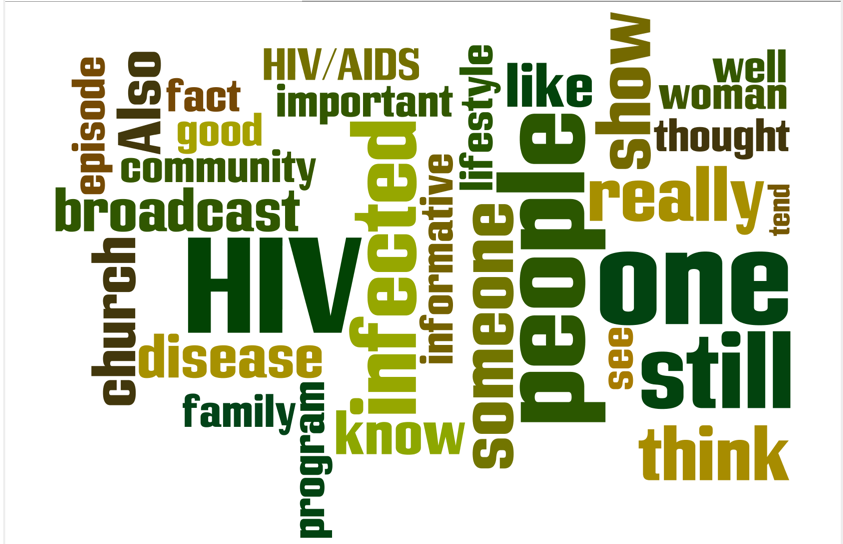
Follow us @myhealthimpact on Twitter. See myhealthimpactnetwork.org for additional content and health information.
Share

June 25, 2014
Here We Are Again
Here we are again. June 27 is National HIV Testing Day. Based on the Centers for Disease Control and Prevention (CDC), over 1 million people in the U.S. are living with HIV. The data are even more pointed – as Blacks/African Americans account for 44% of the population living with HIV.
Michel Martin of National Public Radio (@TellMeMoreNPR) discussed HIV and the Black church during a December 2013 segment. Listening to the segment with the @myhealthimpact research scholars who were, then, undergraduate college students raised many reactions. These reactions are shown below:
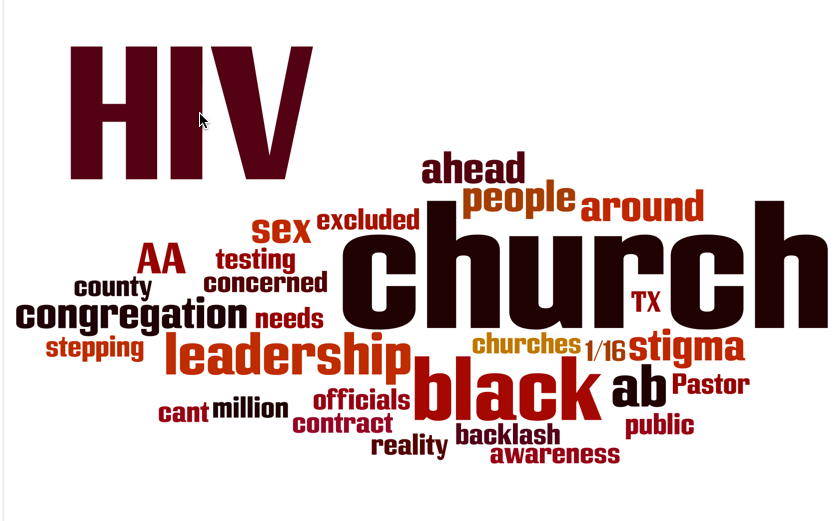
The diagram speaks to the following reactions; some of which were of surprise to the young adults:
- Wow. Half of million!
- My church has never talked about HIV/creates stigma
- Great that this TX pastor (in the NPR segment) is offering HIV testing
- OMG! The ratio of black mean affected with HIV is almost the same of black men in the jail (1/16 and 1/15)
- What IS this stigma surrounding HIV…statistics do not lie because the facts are there!
- Why is the congregation ahead of their leadership—bold statement!
After recently watching the HBO special, The Normal Heart, I asked the team what did they learn? While the special was described as graphic and provided a “visual”, one of scholars offered a few parting words:
“What I learned about HIV awareness has come from this project. We were born in the mid-90s, so the visuals and impact of the virus is not with us. We were not born when Magic made his announcement. The connection is somewhat difficult and missing for us”.
Powerful and even more reason to “Know Your Status”. June 27 is National HIV Testing Day. See the myhealthimpactnetwork.org link to HIV testing centers in your area.
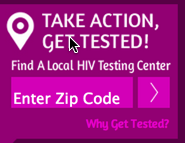
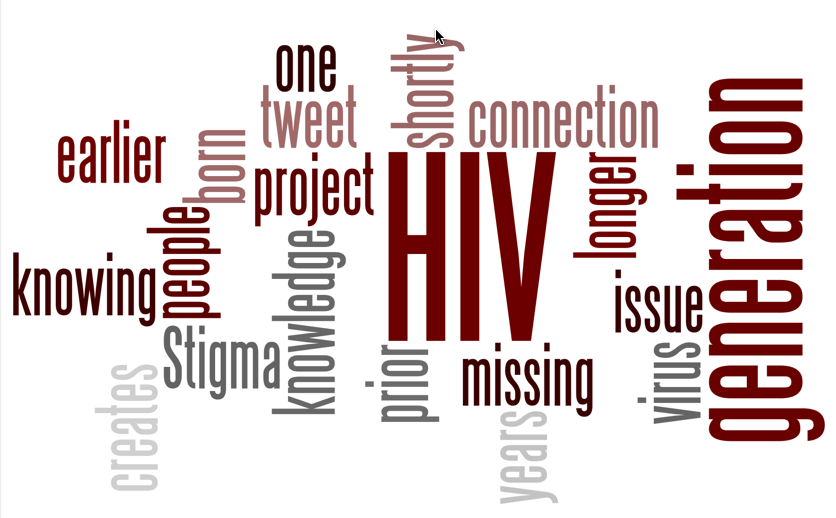
Follow us @myhealthimpact on Twitter and on Tumblr.
Share

March 06, 2014
The TURN UP: Spring Break Safety
With Spring Break literally around the corner, college students everywhere, and I mean EVERYWHERE are gearing up to travel to distance and tropical places to soak up some sun and jump in the water. While most students are only concentrating on getting that last minute workout in for washboards abs or purchasing their last minute wardrobe findings, I guarantee no one is thinking about STDs!
Instead, most college students are thinking about fun, alcohol and parties. Don’t get me wrong, nothing is wrong with having fun and of course making lifetime memories, BUT be SMART about it! Don’t forget about your morals and values, or should I say “home training”. Have “responsible” fun. Yes, spring break is about having a good time and getting away from the books, but don’t be naive.
Drink Responsibly
 Personally, do yourself a favor and party smart. Pace yourself if you choose to drink, and avoid hard alcohol if you can or other drinks that are powerful and have fast effects—cause drunks make for “easy targets”.
Personally, do yourself a favor and party smart. Pace yourself if you choose to drink, and avoid hard alcohol if you can or other drinks that are powerful and have fast effects—cause drunks make for “easy targets”.
According to a study by the University of Wisconsin, 75 percent of college males and 43 percent of females reported being intoxicated on a daily basis during spring break. Which brings me to another point of discussion; don’t let alcohol blur the lines of love! There is no such thing as “I want to get to know you” or “love at first sight” during spring break! Just lust, deceitful lies, and sexual transmitted diseases! So, be smart and not STUPID!
Stay Safe: Safe Sex, Know Your Facts and Know Your Status
The only 100% sure way to prevent sexually transmitted diseases is by not having sex. If you choose to have sex with a stranger—which isn’t best idea—use something called “condoms”. We are college students, so this should not be hard. Stock up on protection before you leave home so you never find yourself in a compromised situation. If this isn’t enough for you, here are the facts: Women are more likely to be victims of sexual violence than men. Women who experience both sexual and physical abuse are significantly more likely to have sexually transmitted diseases. Take precautions and avoid situations or persons that may place you at risk for harm. Decide before even going on spring break what you’re willing to do, and then get to work setting your boundaries early and often. If you meet someone and decide to shack up, be up front with him or her if sex isn’t in the plan. Maybe something like, “Hey good lookin’. I’ve had fun this evening, but no sex tonight.” But seriously, don’t ever let anyone talk you into doing something you’re uncomfortable with.
Keep Safe and Hang With Your Friends
Lastly, “if you go out with your friends, go home with your friends.” It’s one of those things that keeps you a whole lot safer, and eliminates the bad, ugly, and stupid drama. This way you can look out for one another, and get a friend home who is too intoxicated to be out. So this spring break, think a little bit before you act! I’m sure that one week of fun is not worth your life! Don’t turn up too much, so that you look like a fool!
Share

March 06, 2014
Are Sexual Transmitted Diseases (STD’s) still a taboo subject?
Sexually Transmitted Diseases, STDs, have become a topic of discussion that many people feel uncomfortable talking about and try not to think about them, hoping they will go away. As of now there are more than 25 diseases that are transmitted sexually. The organisms, which can cause these diseases usually, enter the body through mucous membranes—such as the surfaces of the vagina, urethra, anus, and mouth.
Listing of Common STDs
How are Sexual Transmitted Diseases (STDs) Caught?
Sexually transmitted diseases can be caught through intimate contact with someone who is infected, especially during oral, anal, or vaginal sex. However, some infections are also transmitted nonsexually. Sexually active college-age men and women are at the highest risk for contracting STDs. With that said, it is important for college students to use protection and get tested regularly.
Symptoms of STDs can be unnoticeable and can lead to more issues if not treated. As adults, it is our responsibility to stay educated on the topic of STDs and continue to utilize health institutions for help and guidance.
If that isn’t enough motivation for you, below are some examples of STDs and images of their effects. I hope this information gives you the courage to help spread the awareness of this issue and practice safe sex, as well as, getting tested.
Pictures of Common STDs




Share

February 27, 2014
Condoms Don’t Protect From Everything
Some people think they know everything there is to know about sexually transmitted diseases. The possibility of catching gonorrhea, syphilis, or even HIV is a scary thought- but some have that perception that they won’t catch anything. Maybe you wear condoms during sexual intercourse so you think that you’re good and have nothing to worry about, right? Well, I must inform you that condoms don’t protect from everything. Even some of the most elite individuals in society are walking around with sexually transmitted diseases. Yes- this is not a joke.
Did You Know Condoms Have a Fail Rate?
Statistics show that condoms have an annual 11% fail rate. Not so safe as you imagined after all… Even when condoms are used, they do not fully protect from sexually transmitted diseases that are passed by skin-to-skin contact. Just this statement alone opens the door for many diseases to walk in and take residence in your body if you are not careful.
Here are some tips you can use in order to lower your risk of catching an STD:
1. Get Tested. Use STD Testing to Know Your Status!
This may sound like an obvious answer but there are still so many people who do not know their std status. I will admit that you fear what you do not know. Having a close friend to go get tested with you can help eliminate that fear you have. That “what if” question will continue to linger until you make the decision to know you status for yourself. We have a specific area on the myHealthImpact website where you can type in your zip code and you will be informed of testing locations that are close to you.
2: Know the Safe Sex Facts For Yourself
There are so many resources available that will provide information on safe sex and sexually transmitted diseases. Saying that you were not informed anymore can no longer be an excuse. Sometimes you have to take the initiative to seek out information for yourself. Ultimately, how can you inform someone about STDs if you don’t know about them yourself?
3. Abstinence.
This is something that the younger generation doesn’t hear a lot about anymore. The media is constantly portraying sex in advertisements, song lyrics and online which makes it seem acceptable. Remaining abstinent until marriage is the only way you will be able to know your status for sure. You don’t run the risk of catching a sexually transmitted disease or early parenthood. This may seem challenging but it is possible. Make a promise to yourself that you will honor and protect your body. Anytime you find yourself being tempted, remember that promise you made to yourself. It will be worth the wait for that special someone.
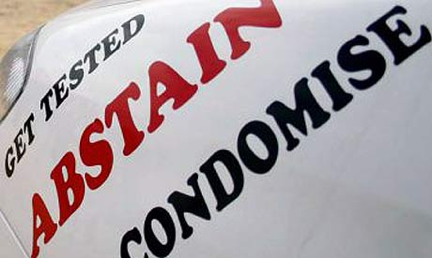
These diseases are REAL people. While all sexually transmitted diseases don’t lead to death, some of them do. Whether you continue to have sex before marriage or wait until marriage is totally up to you. Whatever you decide, I encourage you to be safe. While condoms do protect from some STDs, they don’t protect from everything. Just keep that in mind.
Share

April 20, 2013
Mass Media, Sex, and the HIV Chat
By the time I was 16, I was already aware of what condoms were, how they were used and who used them. As a 20 -year-old graduating college senior, I look back on all I know about HIV. In order to address the discussion of HIV among teens, we must also talk about the sex discussion first because they are related. For one thing, I know that my parents had little to do with the discussion about sexually transmitted diseases. A curious kid at 16, I was also an avid ‘TV-watcher”. Like most of my African-American peers, we always discussed how tv shows like Flavor-of-Love, the Real World and Desperate Housewives influenced us on our view of sex. Because HIV is a sexually transmitted disease, there is much to be said about the virus. My peers and I also know that TV, as a form of mass media sends messages to teens all across the world. Positive messages. Negative messages, perpetuating stereotypes and false information are what is shown to people everyday. Mass media, as defined by sociology dictionary is forms of communication designed to reach a vast audience without any personal contact between the senders and receivers. Examples would include newspapers, magazines, video recordings, radio and television.
As a broadcast journalism major, I was taught that journalism, in lieu of mass media is the fourth estate. The first three estates being the Legislative, Executive and Judicial branch of the government. We are the gatekeepers of information. When I think of a gatekeeper of information, I think of a safeguard. A safeguard is someone who guards, protects and sensors something in a positive or negative way. During my teenage years, the only time I saw HIV awareness or discussion about HIV on TV was during World Aids Day and on December 1st, which is national HIV testing day. The media has more messages of free sex, sex with multiple sex partners and having sex with the absence of love, commitment or respect. There are more reality shows and sitcoms about those topics than shows that address safe sex, monogamy or abstinence. This poses as a threat to the teenage discussion of HIV because they are receive mixed messages that can lead to ignorance. For instance, some teens believe AIDS is the same as HIV, which is false. I’ve also witnessed a discussion at the university level where a student said, “ I need to take an AIDS test”, which is highly inaccurate. Where does the inaccuracy come from, one might add? I am reminded of the huge responsibility TV plays in the discussion of HIV among teenagers. To me, there is no discussion of HIV. I do not feel that the TV industry does a good job of informing the public of the causes and symptoms of HIV/AIDS. For one, I believe that many teens do not know the difference between HIV and AIDS, and that discussion is where the media, as a fourth estate should start.
Follow us at tumblr.myhealthimpactnetwork.org (Tumblr)
Follow us on Twitter @myhealthimpact
Share

February 11, 2013
Philadelphia High Schools Promote Safer Sex
“What has the world come to?” is often a question that floats through my mind as I read the news. Being an African American woman in a predominately Caucasian class is unsettling when the teacher reveals a chart of health statistics and African Americans are highest at risk for practically every sexually transmitted disease. Black women were second in comparison to black men in terms of early death rate; however, African American women are the highest ethnic/ gender group overall to contract sexually transmitted diseases (STDs). Why is this so? One reason that comes to my mind is that females are more likely to go get tested than males. Furthermore, why is the percentage rate of these diseases high in the black community particularly?
Unfortunately, most STDs are contracted and spread by our young people (teenagers & young adults). In my hometown, Philadelphia, STDs are spreading rapidly, especially in the public school system. The mayor, Michael Nutter, noticed the dangerous trend amongst these students and came to a controversial conclusion to disseminate condoms at public schools without parental consent. The majority of public high schools have condom dispensers located in a nurse facility to supply all students with free condom protection. When I was in high school, condoms then were available to students, but we had to have parental consent. This new policy may help solve the problem of the spread of STDs, but created another. Parents are now questioning why their children’s school is “giving them the right to engage in sexual activities”. For more information on this new policy, see http://sexetc.org/
I perfectly understand both sides of the argument. However, I believe that students will choose to have sex regardless of whether or not condoms are free or not (personal decisions). The school system is just educating kids to have safer sex if they are going to have sex at all. The choice to abstain from sexual activity is still available. However, sexually active teens and young adults in the Philadelphia area can http://takecontrolphilly.org/ to find where to go to get free condoms.
Share your thoughts with us. Let us hear from you via a blog comment or on Twitter @myhealthimpact.
Share
In Partnership with: Poole College of Management, College of Humanities and Social Sciences, National Science Foundation, Penn State
Take Action, Get Tested: Find Your Local Testing Center Why Get Tested?
